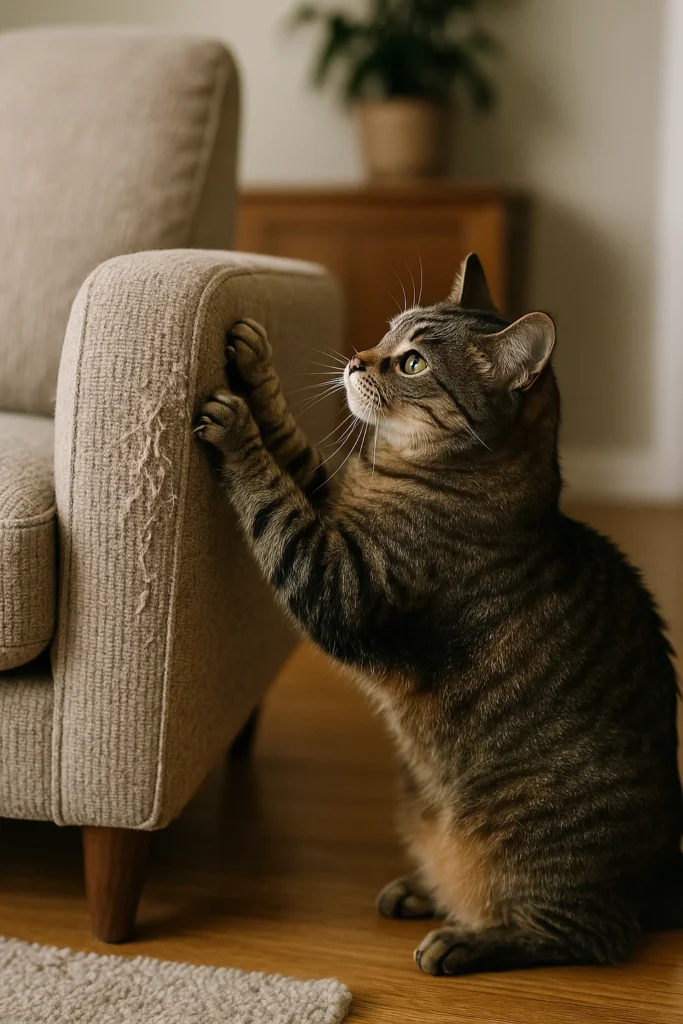🛋️ How to Stop a Cat from Scratching Furniture
Cats have an instinctive need to scratch, but when your favorite sofa becomes their personal scratching post, it can be a real problem. The good news? With the right strategies, you can teach your cat to scratch in more appropriate places—without stress or punishment.
🐱 Why Do Cats Scratch in the First Place?
To stop unwanted scratching, it helps to understand why cats do it. Scratching isn’t just random behavior—it serves important purposes:
- Nail Health: Scratching removes the outer layer of their claws, keeping them healthy and sharp.
- Territory Marking: Cats mark areas using scent glands in their paws, claiming space visually and through smell.
- Muscle Stretching: It’s a great way for them to stretch their back and shoulder muscles.
- Emotional Release: Stress, excitement, or boredom can all lead a cat to scratch more.

🪵 1. Offer Appealing Scratching Alternatives
One of the best solutions is to redirect your cat’s scratching to more suitable options:
- Vertical Scratching Posts: Tall, stable posts wrapped in sisal rope are favorites for many cats.
- Horizontal Scratch Pads: Some cats prefer to scratch flat surfaces—try cardboard or carpeted options.
- Cat Trees and Towers: Multi-functional trees with built-in scratching surfaces give your cat a fun and acceptable outlet.
Tip: Place these items near the areas your cat already scratches. Once they begin using them, slowly move the scratcher to a more convenient location.
🚫 2. Make Furniture Less Attractive to Scratch
Cats often choose furniture because of its texture or location. Try these deterrents:
- Double-sided Tape: Cats dislike the sticky feel.
- Plastic or Foil Covers: These temporary barriers feel unpleasant under paws.
- Natural Repellent Sprays: Citrus or lavender scents (safe for pets) can keep cats away.
Be sure to test sprays on a small area first to avoid damaging upholstery.
🎉 3. Use Positive Reinforcement
Rewarding good behavior is more effective than punishing bad behavior:
- Treats and Praise: When your cat uses a scratching post, offer treats or affection right away.
- Clicker Training: With consistency, you can train your cat to associate certain actions (like scratching the post) with rewards.
✂️ 4. Trim Your Cat’s Claws Regularly
Keeping your cat’s claws short reduces potential damage. Use a claw clipper made for pets, and trim just the sharp tip every few weeks. If you’re unsure how, ask your vet or groomer to demonstrate.
🛡️ 5. Protect Your Furniture
Some extra protection can go a long way, especially while your cat is learning new habits:
- Slipcovers or Throws: Easy to wash and replace.
- Furniture Guards: Transparent shields can protect corners and surfaces your cat targets.
💡 Additional Tips
- Stay Consistent: Mixed signals can confuse your cat. Stick with your chosen method.
- Don’t Punish: Yelling or spraying your cat with water can damage trust and won’t stop the behavior long-term.
- Enrich Their Environment: A bored cat is more likely to scratch. Use toys, window perches, and climbing shelves to keep them stimulated.
✅ Final Thoughts
Cats will always scratch—it’s part of who they are. But with a little patience and the right tools, you can guide them to do it in a way that works for both of you. Providing alternatives, rewarding good behavior, and protecting your furniture are key steps to a scratch-free home.

0 Comments